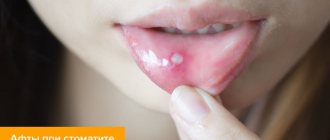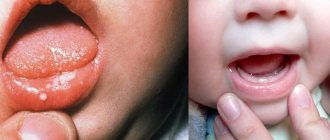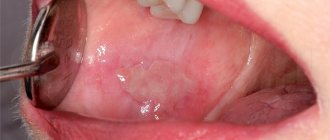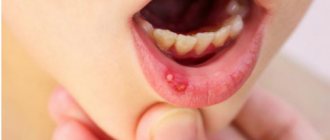About the prevention and treatment of common childhood dental diseases, the causes of candidiasis (thrush) and stomatitis. How can I help my child maintain oral hygiene? Note to parents.
Every parent, when visiting a pediatric dentist, wonders when can they start brushing their teeth? There are many opinions on this matter; some even argue that it is not necessary to clean dairy products. But this is a mistaken opinion. It is known that dental plaque contains pathogenic microorganisms that contribute to the occurrence of caries. It is necessary to accustom your child to brushing his teeth from the age of one. At first, the parent takes care of this himself, and later controls the process. By the age of one year, on average, a child has 8 to 12 teeth. If parents find it difficult to use a toothbrush, you can clean off plaque with gauze wrapped around your finger. This will reduce the trauma that can occur from a toothbrush, because... the child does not immediately begin to understand the meaning of this process. Later, you can start brushing with a soft-bristled toothbrush; you can find one in every pharmacy. There is a variety of choices, both in terms of external indicators and age.
Children's pastes are also varied. You can consult your dentist about your choice. When a child begins to brush his teeth on his own, parents should supervise this process, because children often do it in bad faith, for a short time. It is recommended to clean for up to 5 minutes, removing plaque from top to bottom.
Even despite hygiene, the child is not insured against such childhood diseases as candidiasis and stomatitis. Outwardly they are very similar, parents often confuse them. How to distinguish them and how to treat them?
Causes of thrush in a child’s mouth
The disease can appear in infants literally from birth - in the first week of life. Its causative agent is the yeast-like fungus Candida. This fungus lives in the body constantly and, with good immunity, does not cause any harm, but when some disruptions occur, the disease develops, and then treatment for candidal stomatitis in children cannot be avoided.
The disease can be caused by:
- vaginal candidiasis of the mother (the child becomes infected with the fungus while passing through the birth canal);
- long-term use of antibiotics;
- the presence of any diseases, for example, ARVI;
- teething;
- improper oral hygiene of the baby or lack thereof.
Regardless of the causes of formation, treatment of thrush in newborns should be carried out under the supervision of a medical specialist.
Stomatitis
Stomatitis in a child
There are several types of stomatitis, the most common are herpetic and aphthous . It differs from candidiasis in that it is accompanied by high fever. Bubbles and aphthae appear on the tongue, soft palate, and gums. The child stops eating due to severe pain. Most often, children in kindergartens suffer from stomatitis. They are constantly in contact and put toys in their mouths. If one child gets sick with viral stomatitis, the other is more likely to get infected from him. One of the reasons for refusing a pacifier is not only a violation in the formation of the bite, but also hygiene. Repeatedly, infection occurs from a child who brought a pacifier to kindergarten and lent it to his friends. Reduced immunity can provoke the disease; if relapses occur, laboratory tests are prescribed to rule out common diseases.
Treatment
Treatment for general symptoms of stomatitis is prescribed by a local pediatrician and locally by a pediatric dentist. It includes treating aphthae with sea buckthorn oil, some recommend an aqueous solution of blue, before eating they recommend painkillers gels, soda gargles, and spraying the throat with aerosols. As a rule, stomatitis disappears suddenly, just as it began, and good immunity copes with the disease.
Every parent faced with such problems panics.
These diseases are treated almost every day. This is not a reason to worry, because... everything is treated in a short time, and maintaining hygiene, monitoring the child’s behavior, weaning from bad habits completely eliminates these problems. Moscow metro station Zvezdnaya, Danube Avenue, 23
Symptoms of stomatitis in newborns
As a rule, candidal stomatitis in children begins asymptomatically, so the child does not show concern. As the disease progresses, his behavior changes - the baby refuses to eat and becomes capricious. Due to the active proliferation of the fungus, the taste of food changes, which may explain the lack of appetite.
Pronounced signs that treatment of candidal stomatitis is required in children are:
- a whitish, cheesy coating in the oral cavity - it is especially clearly visible in the morning, after waking up;
- sour breath;
- swelling and redness of the gums.
Candidal stomatitis in children has three degrees of severity. In mild and moderate forms of the disease, the white coating is easily removed, but at the same time areas of bright red mucous membranes are exposed. In severe form, the plaque is already denser. And since it is fused to the mucous membrane, it is quite difficult to remove. And if this succeeds, an eroded mucous membrane with bruises opens. Thrush in a baby’s mouth is usually clearly visible in the early stages, so prompt consultation with a doctor can prevent the development of complications.
Treatment of candidal stomatitis in children must be started in a timely manner, otherwise complications in the form of a secondary infection and the gradual spread of the fungus throughout the child’s body cannot be avoided.
Candidal stomatitis can be identified by the symptoms in the following photos:
Causes of candidal stomatitis
Normally, the yeast-like organism Candida is in the body of every person and does not harm him in any way. When certain conditions arise, fungi begin to actively multiply, which leads to inflammation of the oral mucosa. Such factors include:
- metabolic failures;
- diabetes;
- diseases of the endocrine system;
- hypovitaminosis;
- chronic pathologies of the gastrointestinal tract;
- long-term antibiotic therapy;
- pregnancy;
- use of birth control pills;
- bad habits (alcohol abuse, smoking), etc.
In addition to the mentioned endogenous (internal) causes of candidiasis, there are exogenous (external) causes. These are chemical and mechanical conditions that lead to disruption of the integrity of the skin and oral mucosa. These include: plaque and tartar, sharpened edges of teeth, uncomfortable dentures, chemical contamination, etc.
Clinical treatment
The success of treatment of candidal stomatitis in children can only be said if all sources of infection have been completely eliminated. When the cause of oral disease is the use of antibiotics, in parallel with general treatment, a course of antifungal therapy may be prescribed.
The principle of treating candidal stomatitis in children comes down to creating an alkaline environment in the oral cavity - it is this pH value that is detrimental to fungi. In addition, in an alkaline environment, most pathological microorganisms die, including those that cause carious tooth decay.
The child’s oral cavity can be treated with a solution of baking soda (the optimal concentration will be determined by the attending physician). The procedure for treating candidal stomatitis in children is quite simple: a gauze swab soaked in a solution is used to treat the oral mucosa of the gums and cheeks.
In severe cases, your dentist may prescribe oral medications.
The Doka-Dent dental clinic provides quick and safe diagnostics for effective treatment of stomatitis in infants and older children. Branches in Moscow are located at two addresses:
- Teply Stan district, Leninsky Prospekt, building 131, 1st and 2nd floor. One minute from Troparevo metro station in a building located between Leninsky Prospekt and Academician Bakulev Street.
- Tverskoy district, 1st Tverskaya-Yamskaya, building 27, 2nd floor. Three minutes from any exit from Belorusskaya station in a building located between the first Tverskaya-Yamskaya and the first Brestskaya streets.
Specialists from both clinics conduct examinations free of charge and help urgently prevent the development of complications and the spread of the disease!
Types and forms of pathology
In practice, acute and chronic oral candidiasis occurs. The first develops rapidly, the second is characterized by a sluggish course and vague symptoms, periodic relapses and inflammation.
Acute fungal candidal stomatitis can be pseudomembranous (white plaque is easily removed and reveals reddened areas) and atrophic (there is no plaque, the mucosal surface dries, turns red and becomes painful).
Chronic thrush can be hyperplastic (white or grayish cheesy plaques form on the soft tissues) and atrophic (the oral mucosa dries out, becomes thinner, the patient complains of pain and discomfort).
Pathogens and causes of fungal stomatitis (thrush in the mouth)
The causative agent of the disease is a yeast-like fungal microflora of the genus Candida (hence the name - candidal stomatitis ), and in the overwhelming majority of cases the species Candida albicans. But in more rare cases, fungal stomatitis can also be caused by other types of fungal microflora, for example, Candida tropicalis, krusei, parapsilosis, glabrata.
Fungi of this genus (there are 150 varieties, of which about twenty can cause candidiasis), almost always present on the tissues of the oral cavity, are normally harmless, but do not benefit the body. Their reproduction is controlled by many factors: the chemical balance in the mouth, local and general immunity, and competing bacterial microflora. When these factors are suppressed, the balance is disrupted and the fungus begins to multiply intensively. Actually, candidal stomatitis is not caused by the fungus itself, but by the enzymes it secretes that destroy the components and structure of the epithelium of the mucous membrane.
Therapy for different types of stomatitis
For different stomatitis, therapy is prescribed depending on the type of pathogen . These could be: bacteria, viruses, allergens. An analysis may be required to determine the causative agents of candidiasis, herpes, or bacterial culture.
To successfully treat stomatitis, you need to undergo an examination, follow all the pediatrician’s prescriptions and oral hygiene, and also drink plenty of chamomile or calendula tea.
Sometimes inexperienced young mothers do the wrong procedures or take medications on their own, which further aggravates the situation. In this case, before consulting a pediatrician or ENT specialist, you can only take painkillers and antiseptics.
Such drugs for stomatitis are prescribed containing benzocaine, chlorhexidine, lidocaine. If stomatitis is of viral etiology, the doctor will prescribe antiviral drugs. With bacterial stomatitis, symptoms depend on the type of microorganism. In cases of mild to moderate severity, antiseptics, painkillers and antibiotics will suffice.
You can use a spray containing lidocaine , however, for children under 2 years of age, this product only treats erosions and does not irrigate the oral cavity. After 4 years, children can dissolve Hexoral Tabs tablets. For all types of stomatitis, you can use the herbal mixture "Stomatofit", and do not forget to treat the oral cavity with a soda solution.
Hexoral Tabs tablets
With catarrhal stomatitis, the mucous membrane is not severely damaged; it occurs as a side infection of measles or scarlet fever. Rinsing with a solution of carrot, beet and cabbage juices with warm boiled water gives good results.
Traditional medicine recommends herbal infusions, Kalanchoe and aloe juices. Propolis tincture has pronounced antimicrobial properties.
How to treat fungal stomatitis?
In order not only to reduce inflammation of the mucous membrane, but also to prevent relapses, treatment of candidal (fungal) stomatitis in adults and children is carried out only in a comprehensive manner. Therapy involves taking several drugs at once:
- antimycotics – antifungal drugs for topical use;
- local antiseptic solutions for rinsing and irrigation (to prevent additional infection);
- antihistamines (recommended for the development of allergies to fungal activity);
- vitamin complexes (to eliminate deficiency of substances in the body).
To speed up recovery, the patient will have to follow a special diet. It is necessary to restore the mucous membranes of the oral cavity and pharynx.
Often sick patients are interested in how to treat candidal stomatitis at home, putting off going to the dentist. But it is impossible to cure candidiasis at home. Probably, it will only be possible to relieve the acute symptoms of the pathology, which will manifest itself again after a while. To prevent inflammation from becoming chronic, you should consult a doctor as soon as you notice the first symptoms of the disease.








